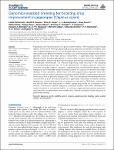| dc.contributor.author | Pazhamala, Lekha | |
| dc.contributor.author | Saxena, Rachit K. | |
| dc.contributor.author | Singh, Vikas K. | |
| dc.contributor.author | Sameerkumar, C. V. | |
| dc.contributor.author | Kumar, Vinay | |
| dc.contributor.author | Sinha, Pallavi | |
| dc.contributor.author | Patel, Kishan | |
| dc.contributor.author | Obala, Jimmy | |
| dc.contributor.author | Kaoneka, Seleman R. | |
| dc.contributor.author | Tongoona, P. | |
| dc.contributor.author | Shimelis, Hussein A. | |
| dc.contributor.author | Gangarao, N. V. P. R. | |
| dc.contributor.author | Odeny, Damaris | |
| dc.contributor.author | Rathore, Abhishek | |
| dc.contributor.author | Dharmaraj, P. S. | |
| dc.contributor.author | Yamini, K. N. | |
| dc.contributor.author | Varshney, Rajeev K. | |
| dc.date.accessioned | 2023-02-09T10:06:32Z | |
| dc.date.available | 2023-02-09T10:06:32Z | |
| dc.date.issued | 2015 | |
| dc.identifier.citation | Pazhamala, L., Saxena, R. K., Singh, V. K., Sameerkumar, C. V., Kumar, V., Sinha, P., ... & Varshney, R. K. (2015). Genomics-assisted breeding for boosting crop improvement in pigeonpea (Cajanus cajan). Frontiers in plant science, 6, 50. | en_US |
| dc.identifier.uri | https://doi.org/10.3389/fpls.2015.00050 | |
| dc.identifier.uri | http://ir.lirauni.ac.ug/xmlui/handle/123456789/501 | |
| dc.description.abstract | Pigeonpea is an important pulse crop grown predominantly in the tropical and sub-tropical
regions of the world. Although pigeonpea growing area has considerably increased, yield
has remained stagnant for the last six decades mainly due to the exposure of the crop to
various biotic and abiotic constraints. In addition, low level of genetic variability and limited
genomic resources have been serious impediments to pigeonpea crop improvement
through modern breeding approaches. In recent years, however, due to the availability of
next generation sequencing and high-throughput genotyping technologies, the scenario
has changed tremendously. The reduced sequencing costs resulting in the decoding
of the pigeonpea genome has led to the development of various genomic resources
including molecular markers, transcript sequences and comprehensive genetic maps.
Mapping of some important traits including resistance to Fusarium wilt and sterility mosaic
disease, fertility restoration, determinacy with other agronomically important traits have
paved the way for applying genomics-assisted breeding (GAB) through marker assisted
selection as well as genomic selection (GS). This would accelerate the development and
improvement of both varieties and hybrids in pigeonpea. Particularly for hybrid breeding
programme, mitochondrial genomes of cytoplasmic male sterile (CMS) lines, maintainers
and hybrids have been sequenced to identify genes responsible for cytoplasmic male
sterility. Furthermore, several diagnostic molecular markers have been developed to
assess the purity of commercial hybrids. In summary, pigeonpea has become a genomic
resources-rich crop and efforts have already been initiated to integrate these resources in
pigeonpea breeding. | en_US |
| dc.language.iso | en | en_US |
| dc.publisher | Frontiers in plant science | en_US |
| dc.subject | pigeonpea | en_US |
| dc.subject | genetic variability | en_US |
| dc.subject | genomic resources | en_US |
| dc.subject | genomics-assisted breeding | en_US |
| dc.subject | marker assisted selection | en_US |
| dc.subject | genomic selection | en_US |
| dc.title | Genomics-assisted breeding for boosting crop improvement in pigeonpea (Cajanus cajan) | en_US |
| dc.type | Article | en_US |

